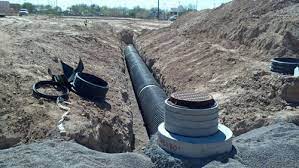Sewerage systems form the backbone of urban infrastructure, ensuring the safe and efficient removal of wastewater from homes, businesses, and industries. The construction of a sewerage system is a complex and meticulous process that requires careful planning, engineering expertise, and adherence to environmental standards. In this article, we will provide a comprehensive guide to the construction of sewerage systems, covering key phases, materials, and considerations for building resilient and sustainable wastewater infrastructure.
Preliminary Planning:
The initial phase of sewerage system construction involves comprehensive planning. City planners, engineers, and environmental experts collaborate to assess the existing urban landscape, demographic trends, and future growth projections. Key considerations include population density, topography, existing infrastructure, and environmental impact assessments. This phase lays the foundation for designing a system that meets the specific needs of the community.
Design and Engineering:
Once the preliminary planning is complete, engineers proceed to design the sewerage system. This involves creating detailed blueprints that specify the layout of pipes, the location of treatment plants, and the integration of stormwater management components. Engineers also consider the type of sewerage system – whether combined or separate – based on the specific requirements and challenges of the urban environment.
Material Selection:
The choice of materials is a critical aspect of sewerage system construction. Common materials for sewer pipes include:
- PVC (Polyvinyl Chloride): Known for its durability, corrosion resistance, and affordability.
- Concrete: Ideal for larger pipes and offers strength and longevity.
- HDPE (High-Density Polyethylene): Lightweight, flexible, and resistant to corrosion.
- GRP (Glass Reinforced Plastic): Corrosion-resistant and suitable for aggressive environments.
The selection depends on factors such as soil conditions, the corrosive nature of wastewater, and the anticipated lifespan of the system.
Construction Phases:
Excavation and Trenching: The construction process begins with excavation and trenching to create pathways for the sewer pipes. Modern techniques, such as trenchless technology. Minimize disruption by allowing pipes to be installed without extensive excavation.
Pipe Installation: Once trenches are prepared, pipes are laid according to the design specifications. Proper alignment and slope are crucial to ensure the flow of wastewater towards treatment plants. Advanced technologies, including robotics and laser-guided equipment, assist in precise pipe installation.
Manhole and Access Point Construction: Manholes and access points construct at strategic locations to facilitate inspection, maintenance, and ventilation within the sewerage system. These structures provide entry points for workers and play a crucial role in managing gas buildup within the system.
Connection to Treatment Plants: The sewer pipes connected to treatment plants. Where wastewater undergoes various processes to remove impurities. The design of these connections ensures a smooth flow and efficient treatment.
Stormwater Management Components: For combined sewerage systems, the construction includes stormwater management components like detention basins and retention ponds. These structures help manage excess stormwater during heavy rainfall, preventing flooding and reducing the risk of combined sewer overflows.
Quality Assurance and Compliance:
Throughout the construction process, quality assurance measures are implemented to ensure the integrity and longevity of the sewerage system. Compliance with environmental regulations and safety standards is paramount. Inspection and testing protocols are employed to verify the quality of materials. The accuracy of installations, and the overall performance of the system.
Environmental Considerations:
Sewerage system construction involves a commitment to environmental sustainability. Erosion control measures are implemented to prevent soil runoff, and best practices are followed to minimize disturbances to ecosystems and water bodies. Green infrastructure elements, such as permeable pavements and vegetation, may integrated to enhance environmental resilience.
Community Engagement:
Transparent communication with the community is essential during sewerage system construction. Public awareness campaigns, regular updates, and collaboration with local stakeholders help minimize disruptions and address concerns. Involving the community in the construction process fosters a sense of ownership and awareness about the importance of wastewater management.
Conclusion:
Constructing a sewerage system is a multifaceted process that demands meticulous planning, engineering precision, and environmental stewardship. As urban areas continue to grow, the construction of resilient and sustainable sewerage systems becomes increasingly vital. By embracing modern technologies, adhering to rigorous quality standards, and fostering community engagement, cities can build wastewater infrastructure that not only meets the needs of today but also lays the foundation for a sustainable and hygienic future.

